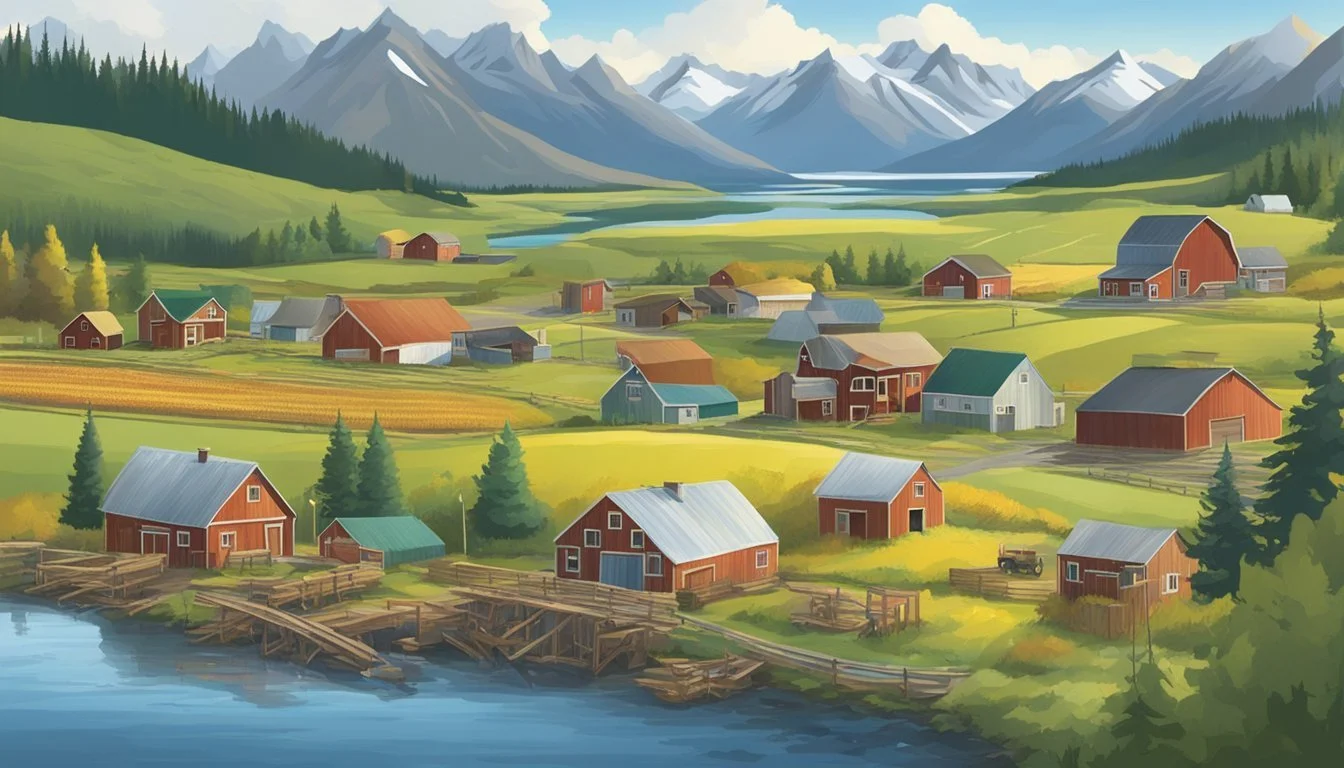Farming Communities in Alaska
Sustainable Practices in Harsh Climates
Nestled in the expansive landscapes of Alaska, farming communities face unique challenges and opportunities. Agriculture in Alaska is shaped by a short growing season and challenging climate, yet the exceptionally long summer days allow certain crops to thrive. The number of farms in Alaska has increased by 18% in recent years, reflecting a growing commitment to local agriculture.
In rural areas, these farming communities often rely on both traditional farming and wild harvest resources. Alaska Natives, for instance, have a deep cultural connection to the land and sea, which is essential for food security. Despite these efforts, the local food supply still falls short of meeting demand, making the state heavily dependent on imported food.
Agriculture in Alaska, though limited, creates significant products including record-size vegetables thanks to the long daylight hours. Yet, the state’s reliance on food imports makes it vulnerable to supply chain disruptions. Highlighting the resilience and resourcefulness of these farming communities reveals much about the broader challenges and innovations in Alaska's agricultural landscape.
Historical Context of Alaskan Farming
Farming in Alaska has evolved from indigenous agricultural practices to modern methods introduced by settlers. Each phase reflects the adaptation to the region's unique climate and geography.
Indigenous Agricultural Practices
Indigenous communities in Alaska have a long history of harvesting native plants and foods. These communities relied on traditional foods such as berries, roots, and various species of fish. Gardening and small-scale farming were complementary to hunting and fishing.
The techniques used by Alaska Native communities were well-suited to the subarctic climate. They employed methods like preserving and drying food to ensure sustenance throughout the harsh winters. This approach to agriculture was not just about food production but also cultural practices and sustainability.
Introduction of Modern Farming
Modern farming in Alaska began with the arrival of settlers and expanded significantly in the early 20th century. Charles C. Georgeson’s expedition tested the feasibility of crops in the cold environment. Despite initial skepticism, this experiment proved successful.
The Matanuska Valley became a focal point for agricultural development. During the Great Depression, 203 families were relocated here to establish farming communities. Improved techniques, longer growing seasons, and innovations in crop variety allowed this sector to flourish. This period marked a significant shift from subsistence practices to commercial agriculture.
Geographic and Climatic Conditions
Farming communities in Alaska must navigate unique geographic and climatic conditions, including extreme temperatures, permafrost, and a boreal forest ecosystem, along with the added burden of climate change impacting agriculture.
Unique Challenges in Alaska
Alaska's farming regions face significant challenges due to their geographic location and climatic peculiarities. The state experiences extreme seasonal temperature variations, with long, harsh winters and brief, but intense, growing seasons.
Permafrost, or permanently frozen ground, restricts root growth and soil manipulation, making traditional farming techniques difficult. Farming communities rely on creative approaches, such as raised beds and greenhouses, to extend the growing season and protect crops.
Furthermore, Alaska’s boreal forests dominate much of the rural landscape, necessitating clearings for agricultural activities. Soil conditions also vary widely, from poorly drained wetlands to well-drained uplands, requiring farmers to adapt their methods to local soil types.
Climate Change Impact on Agriculture
Climate change has begun to alter agricultural practices in Alaska. Increased temperatures have led to longer growing seasons, providing an advantage to farmers in certain areas. However, these benefits come with heightened risks, including unpredictable weather patterns and extreme events.
Melting permafrost presents another major issue, as it destabilizes the soil, affecting both crop viability and infrastructure. Shifts in the forest ecosystem, such as changes in the boreal forest composition, also affect available resources and land usability for farming.
Tools like the Alaska Garden Helper provide crucial data to farmers, helping them plan for future climatic shifts. This tool offers detailed, location-specific climate projections, assisting communities to adapt and optimize their agricultural practices in response to ongoing environmental changes.
Agricultural Practices in Alaska
Agriculture in Alaska involves distinct practices due to its unique climate and geographic conditions. The short growing season and challenging soils impact crop production, while livestock and poultry management are adapted to local environmental factors.
Crop Production and Seasonality
Alaskan farmers face a short growing season but benefit from long daylight hours during summer. Common crops include potatoes, barley, and various vegetables such as cabbage and carrots.
The soils tend to be acidic and poorly drained, requiring specific amendments and practices to improve fertility and drainage. Raised beds and greenhouses are often used to extend the growing season and protect plants from the cold.
Wildlife can pose a threat to crops, necessitating the use of fencing and other deterrents. Forests provide some shelter, but they also harbor pests. Crop rotation and cover cropping are implemented to maintain soil health and manage pests naturally.
Livestock and Poultry Management
Livestock, including cattle, sheep, and goats, are raised with a focus on adapting to the harsh climate. Cold-resistant breeds are preferred. Poultry farming includes chickens and turkeys, which are often housed in insulated coops to withstand the cold.
Grazing is managed to prevent overuse of limited pastures, and feed is often imported to supplement local resources. Animal welfare practices are critical, especially during the harsh winter months when shelter and warmth are vital.
Farmers also take measures to protect livestock and poultry from wildlife predators such as bears and wolves, employing secure fencing and guard animals. The integration of sustainable practices, like rotational grazing and manure management, helps maintain ecosystem balance and soil health.
Sustainability and Conservation Efforts
Efforts in Alaska focus on preserving wildlife and habitats, as well as conserving soil and water resources. These measures are critical for maintaining the region’s ecological balance and supporting its farming communities.
Wildlife and Habitat Preservation
Alaska's vast landscapes and unique ecosystems are a haven for a wide range of wildlife. Key initiatives emphasize the conservation of critical habitats, particularly in areas like the Tongass National Forest. This includes protecting wetlands, forests, and coastal regions that serve as vital breeding grounds for species such as salmon and the endangered Alexander Archipelago wolf.
Conservation groups and government agencies collaborate to implement wildlife corridors that allow animals to migrate safely. Carbon sequestration plays a significant role in these efforts by enhancing forest health, which in turn supports diverse fauna. Restoration projects also focus on reforesting areas that have been degraded, ensuring that natural habitats can sustain wildlife populations.
Soil and Water Conservation
Alaska's farming activities depend heavily on soil and water resources. Conservation practices include contour farming, which reduces soil erosion, and crop rotation to maintain soil fertility. These techniques help maintain robust agricultural lands, which are essential for the sustainability of farming communities.
Water management is another critical aspect, involving measures like irrigation efficiency and the protection of watersheds. These initiatives ensure that clean water is available for both agricultural use and the broader ecosystem. Projects that aim to restore wetlands also contribute to better water quality and flood control, benefiting both wildlife and human inhabitants.
Through a combination of innovative and traditional conservation techniques, Alaska continues to foster a sustainable environment that supports both its robust wildlife population and its farming communities.
The Economic Landscape
Farming in Alaska presents unique economic dynamics shaped by its remote location, climatic challenges, and innovative agricultural practices. These factors create both opportunities and challenges for local farmers and communities.
Agricultural Economics in Alaska
Agricultural economics in Alaska revolves around several factors including climate-related adjustments, market access, and investments from entities like the USDA. Unlike many states, Alaska's agricultural sector is notable for its small-scale farms. Nearly 46% of its farmers have less than a decade of experience, reflecting a trend of new and beginning producers.
The diverse climatic conditions significantly influence what crops are economically viable, requiring a blend of traditional knowledge and modern techniques. This dual approach helps farmers make the best use of shorter growing seasons and extreme weather conditions. The emphasis is on sustainable practices and efficient resource use, with farming communities often dependent on imported food given that 95% of Kodiak's food is sourced from outside the region.
Economic Opportunities and Challenges
Economic opportunities in Alaska's farming communities are emerging despite the harsh conditions. The state has seen a 44% rise in the number of farms between 2007 and 2017, largely due to small-scale ventures. These farms, often between nine acres or less, benefit from innovative local programs and educational initiatives aimed at improving harvest yields and farm sustainability.
Investment from governmental bodies such as the USDA plays a pivotal role. Programs focusing on rural development and food security are critical. The rise in temperature and changing climate surprisingly provides a longer growing season which could eventually open up more avenues for diverse farming ventures.
However, challenges include high operational costs, limited local markets, and the need for continual adaptation to climate change. Achieving economic stability requires balancing traditional practices with new agricultural technologies to ensure both productivity and sustainability.
Innovation and Technology in Agriculture
Advancements in farming technologies are significantly influencing agricultural practices in Alaska. Key innovations include hydroponics systems and the integration of renewable energy sources like biomass.
Hydroponics and Alternative Farming
Hydroponics offers a viable solution for Alaskan farmers dealing with short growing seasons and harsh climates. This soilless cultivation method allows plants to grow in nutrient-rich water, optimizing space and resources.
Research supports that hydroponics can yield higher production rates compared to traditional farming. It enables multiple crop cycles annually regardless of outdoor conditions.
Farmers utilize controlled environments, such as greenhouses, to maintain optimal growing conditions. Techniques like vertical farming maximize space usage, making it particularly effective for regions with limited arable land.
Renewable Energy and Agriculture
Incorporating renewable energy sources is crucial for sustainable farming. Biomass, wind, and solar energy are increasingly deployed across Alaskan farms, reducing reliance on fossil fuels.
Biomass energy, derived from organic materials like crop residues, serves as a renewable energy source. It provides heating for greenhouses and powers agricultural machinery.
Wind and solar installations harness natural energy, significantly lowering operational costs. These technologies not only contribute to environmental conservation but also ensure energy security for remote farming communities.
Renewable energy systems are becoming an integral part of Alaskan agriculture, driving both sustainability and economic resilience.
Fishing and Aquaculture
Fishing and aquaculture are vital to Alaska's economy and environmental sustainability. This section explores the prominence of salmon fisheries and the growing significance of mariculture, including kelp farming.
Salmon Fisheries and Sustainability
Alaska's salmon fisheries are renowned worldwide. They are managed with a focus on sustainability to ensure the long-term health of salmon populations. The state employs strict regulations and monitoring to prevent overfishing.
Commercial and subsistence fishing play crucial roles in Alaskan communities. Fishermen rely on species like sockeye, king, and pink salmon. Sustainability involves the use of precautionary catch limits and seasonal closures. These measures protect the ecosystem while supporting the economy.
Mariculture and Kelp Farming
Mariculture, or marine aquaculture, has been expanding in Alaska, focusing on shellfish and seaweed farming. Kelp farming, in particular, has seen notable growth. Kelp grows rapidly and helps mitigate ocean acidification by absorbing carbon dioxide.
Kelp farming provides economic opportunities for coastal communities. It involves cultivating seaweed species like sugar kelp and ribbon kelp. The crops are used in food, cosmetics, and fertilizers.
The Alaskan government and organizations like NOAA support mariculture through research and grants. These efforts ensure that the industry benefits both the environment and local economies.
Local and Traditional Foods
Farming communities in Alaska have a deep connection to their local and traditional foods through unique practices of harvesting native plants and managing wild resources. These methods sustain their culture and food sovereignty.
Harvesting and Use of Native Plants
In Alaska, many communities rely on native plants as essential parts of their diet. Plants such as wild berries, mushrooms, and fireweed are harvested seasonally.
Fireweed, for example, is used to make jellies and teas.
Mushrooms gathered from the boreal forest serve as fungi for various dishes.
The coastal regions offer different varieties of edible seaweed. Native plants provide both nutritional benefits and medicinal uses.
Harvesting, often done in summer, sustains food supplies through winter.
Traditional knowledge passed down through generations ensures the proper timing and methods for gathering these plants.
Wild Resource Management
Managing wild resources in Alaska involves a mix of tradition and modern practices.
Fish, caribou, and moose are crucial for many villages, hunted under regulated seasons to prevent overharvesting.
Efforts to address food insecurity include fish camps where families work together to preserve fish for the year.
Regulations ensure sustainable yields, mitigating the impacts of overuse.
Cultural practices, such as sharing meat from hunts, reinforce community bonds.
Also, managing boreal forest fires is vital to preserving habitats for these wild resources.
These comprehensive management strategies prioritize sustainability and community resilience.
Community and Education
Farming communities in Alaska greatly benefit from targeted education programs and agricultural extension services that support sustainable practices and address the distinct challenges faced by rural areas.
Role of Education in Farming Communities
Educational initiatives in Alaska's farming communities focus on integrating local food sourcing and agricultural education into school systems. The National Farm to School Network acts as a hub for information, advocacy, and networking. These programs not only teach children about agriculture but also promote healthier eating habits by incorporating local foods into school meals. The USDA supports these efforts through the Office of Community Food Systems (OCFS), which helps child nutrition programs include local produce.
In addition, organizations such as NEA-Alaska address the unique needs of educators in rural settings. The Policy Assembly for Rural and Small Associations (PARSA) amplifies the voices of these educators, ensuring that the challenges specific to rural farming communities are heard and addressed.
Agriculture Extension Services and Support
Agriculture extension services play a crucial role in supporting Alaskan farmers, particularly in rural areas. The University of Alaska's Cooperative Extension Service (CES) offers resources and support through various programs, including the Sustainable Agriculture Research and Education (SARE) initiative. Located in places such as the Kenai Peninsula District, these services provide essential information, training, and technical assistance to farmers.
Community-focused projects like Alaska Resilience Farms (ARF) also contribute to local agriculture by fostering partnerships between community gardens, hydroponic farms, and educational institutions. These collaborations enhance food security and sustainability in both underserved rural and urban communities.
Extension services and community projects provide a valuable network of support, promoting resilience and growth in Alaska's farming communities.
Government Policies and Support
Government support plays a crucial role in bolstering farming communities in Alaska. Key players include the U.S. Department of Agriculture and specific initiatives by the Biden-Harris Administration aimed at enhancing sustainability and resilience.
U.S. Department of Agriculture's Role
The U.S. Department of Agriculture (USDA) has implemented numerous strategies to support farming communities in Alaska. They have invested in infrastructure development and programs to facilitate local food production.
For instance, the USDA 2501 grant enabled the Kodiak Archipelago Leadership Institute to improve access to USDA programs and resources. This initiative empowers local farmers and Alaska Natives to grow their own fresh produce, significantly reducing reliance on imported food.
In addition, USDA Secretary Tom Vilsack announced a $42 million investment aimed at mitigating climate change impacts on rural communities. This funding is part of the broader Build Back Better agenda, which seeks to create good-paying jobs and support sustainable agricultural practices in Alaska.
Biden-Harris Administration Initiatives
The Biden-Harris Administration has also launched initiatives tailored for Alaskan farming communities. These efforts are designed to foster economic diversity and sustainability in the region.
One noteworthy project is the Southeast Alaska Sustainability Strategy, introduced to promote a diverse economy and conserve natural resources. This strategy involves consultations with Tribes and Alaska Native corporations, emphasizing the importance of Tribal sovereignty and collaborative approaches.
The administration's focus on rural development is evident through multiple infrastructure projects, including 21 new initiatives announced by USDA's Rural Development State Director for Alaska. These projects, backed by a $9.2 million investment, aim to improve essential infrastructure services in rural areas, supporting both local agricultural practices and community resilience.
Future of Farming in Alaska
The future of farming in Alaska faces transformative potential amidst climate change, with the state's food security and resilience heavily influenced by the evolving environment.
Trends and Prospects
Agricultural expansion in Alaska is showing significant promise. The number of farms increased by 30% from 2012 to 2017, indicating a growing interest in local food production. This surge can mitigate Alaska’s current reliance on importing 95% of its food, enhancing food security.
Climate change plays a notable role in these trends. Warmer temperatures and extended growing seasons might introduce new crop varieties previously unsuited to Alaska’s climate. Potential crops include root vegetables and hardy greens, which thrive in slightly warmer conditions.
However, sustaining this growth requires investment in education and training for new farmers. Institutions and experts must provide guidance on best practices for farming in unique Alaskan conditions, such as managing permafrost and limited daylight in winter. These efforts can ensure long-term sustainability and productivity.
Adapting to Environmental Changes
Adaptation to the changing environment is critical. As permafrost thaws, it can alter soil composition and stability, posing challenges for farming. Farmers need to adopt innovative techniques to manage these changes, such as utilizing raised beds and greenhouses to extend growing periods.
Resilience against climate disruptions is also key. Developing resilient farming systems that can withstand unpredictable weather patterns ensures consistent food production. This includes diversifying crops and implementing advanced irrigation systems to manage water resources effectively.
Equity in resource distribution and support is essential. Ensuring all farming communities, including those in remote areas, have access to the necessary tools and knowledge fosters an equitable agricultural landscape. This strategic support enhances food security, making Alaska less dependent on external food sources and more self-reliant.
Finally, collaboration between local communities, agricultural experts, and policymakers can drive these adaptive strategies. By embracing change and innovation, Alaska's farming future can be both resilient and prosperous.








